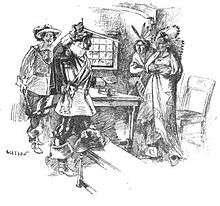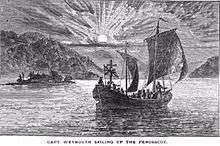George Weymouth

George Weymouth (Waymouth)(c. 1585-c. 1612) was an English explorer of the area now occupied by the state of Maine.

Voyages
George Weymouth (c. 1585-c. 1612) was a native of Cockington, Devon, who spent his youth studying shipbuilding and mathematics.
In 1602 Weymouth was hired to seek a northwest passage to India by the recently formed East India Company.[1] He sailed the ship Discovery 300 miles into Hudson Strait[2] but turned back on July 26, as the year was far spent and many men were ill. Weymouth reached Dartmouth on September 5, 1602.
In March 1605 Thomas Arundell, 1st Baron Arundell of Wardour and Henry Wriothesley, 3rd Earl of Southampton sent Captain Weymouth to found a colony in Virginia under the ruse of searching again for a northwest passage.[3] Weymouth sailed from England on March 31, 1605 on the ship Archangel[4] and landed near Monhegan off the coast of Maine on May 17, 1605. James Rosier, who accompanied Weymouth on this expedition, would write that Monhegan was
"woody, growen with Firre, Birch, Oke and Beech, as farre as we say along the shore; and so likely to be within. On the verge grow Gooseberries, Strawberries, Wild pease, and Wilde rose bushes."[5]
Weymouth named the island Saint George after the patron saint of England.[4]
Weymouth then explored the coast of Maine, including Penobscot Bay, arriving in Cape Cod on May 11, befriending the Patuxet natives, introducing them to English green peas, and impressing them with his magic by magnetizing his sword and picking up metal objects[6] before using their love of peas to kidnap five, returning to England in mid June.[7] They were Assacumet, Manida, sagamore Nahanada/Dehanada, Skitawarroes, and Tisquantum (Squanto); Weymouth presented the latter three to Sir Ferdinando Gorges, governor of Plymouth Fort, piquing his interest in exploration.[8] Gorges went on to teach his captives English and send them back, saying "The capture of these Indians must be acknowledged the means, under God, of putting on foot and giving life to all our plantations."[6]
In Britain, the North American tree species Pinus strobus is referred to as the "Weymouth Pine", in honor of George Weymouth.
In July 2005 the Historical Society of Thomaston, Maine celebrated the 400 anniversary of Weymouth's voyage to Maine.[9]
References
- ↑ Dunbabin, Thomas "Waymouth, George", Dictionary of Canadian Biography, vol. 1, University of Toronto/Université Laval, 2003–, accessed November 5, 2015
- ↑ Glyn Williams,"Arctic Labyrinth",2009, p. 45
- ↑ Akrigg, G.P.V. (1968). Shakespeare and the Earl of Southampton. Cambridge, Massachusetts: Harvard University Press
- 1 2 Drake, Samuel Adams. The Pine-tree Coast, (Estes & Lauriat, 1890), 218.
- ↑ " Rosier's Relation of George Weymouth's 1605 Voyage", in Ronald F. Banks, Ed., 1969, A History of Maine: A Collection of Readings on the History of Maine 1600 - 1974, Third Edition, scanned online by Davistown Museum, accessed 20 Oct 2009
- 1 2 http://www.kellscraft.com/StoriesOfMaine/StoriesOfMaineCh03.html
- ↑ "Annual Report of the Director, United States Coast and Geodetic Survey, to the Secretary of Commerce", U.S. Coast and Geodetic Survey, 1885
- ↑ "The Plymouth Company", Report and Transactions of the Devonshire Association for the Advancement of Science, Literature, and Art, Vol. 14, Devon, England, 1882, pg. 342
- ↑ The Waymouth 400th Anniversary Celebration